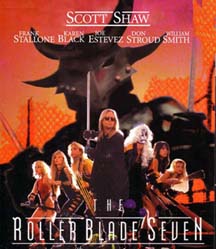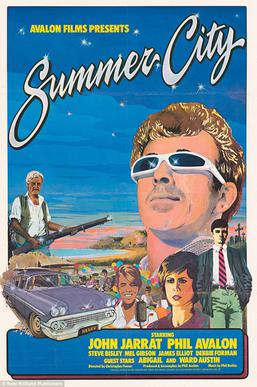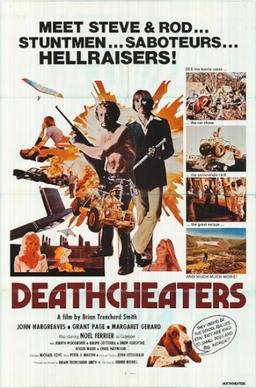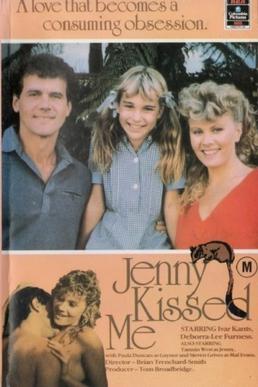
Frank Oz is an American puppeteer, filmmaker and actor. He is best known for his involvement with Jim Henson and George Lucas through the Muppets, Sesame Street, and Star Wars, as well as his directorial work in feature films and theater.

Clerks is a 1994 American black-and-white comedy film written and directed by Kevin Smith in his feature directorial debut.

BMX Bandits is a 1983 Australian crime comedy action film directed by Brian Trenchard-Smith and starring Nicole Kidman.

James Milton Kelly was an American athlete, martial artist, and actor. After winning several karate championships, Kelly rose to fame in the early 1970s appearing in various action films within the martial arts and blaxploitation genres. Kelly played opposite Bruce Lee in 1973's Enter the Dragon, and had lead roles in 1974's Black Belt Jones as the title character and Three the Hard Way as Mister Keyes.

The Roller Blade Seven is a 1991 cult martial arts film directed by Donald G. Jackson, written by Jackson and Scott Shaw, produced by Jackson and Shaw, and starring Shaw, Frank Stallone, Karen Black, Joe Estevez, Don Stroud, and William Smith.

Summer City is a 1977 Australian drama thriller film, filmed in Newcastle, Australia. It marked Mel Gibson's film debut.

Brian Medwin Trenchard-Smith is an English-Australian filmmaker and author, known for his idiosyncratic and satirical low-budget genre films. His filmography covers action, science fiction, martial arts, dystopian fiction, comedy, war, family, thriller, romance and erotica, and his works tend to be cross-genre pieces.

Turkey Shoot is a 1982 Australian dystopian action film directed by Brian Trenchard-Smith. Its ensemble cast — an eclectic mix of international stars, Australian soap opera veterans and character actors — is led by Steve Railsback, Olivia Hussey, Michael Craig, Noel Ferrier, Carmen Duncan, Roger Ward and Lynda Stoner. The film marks the first of three directorial collaborations between Trenchard-Smith and producer Antony I. Ginnane — the others being The Siege of Firebase Gloria (1989) and Arctic Blast (2010) — although the director had previously made promotional reels and trailers for Ginnane's earlier films.
Day of the Assassin is a 1979 American-Spanish-Mexican action film directed by Brian Trenchard-Smith, who called it "a trainwreck of a movie."
Early Frost is a 1982 Australian thriller film starring Guy Doleman, Jon Blake, Diana McLean and David Franklin.

The Man from Hong Kong, originally released in the US as The Dragon Flies, is a 1975 action film written and directed by Brian Trenchard-Smith in his directorial debut and starring Jimmy Wang Yu and George Lazenby, with Hugh Keays-Byrne, Roger Ward, Rosalind Speirs, Rebecca Gilling, Sammo Hung, Grant Page and Frank Thring in supporting roles. The first film to be made as an international coproduction between Australia and Hong Kong, it serves as a satire of the James Bond and Dirty Harry franchises, combined with tropes of the concurrent chopsocky craze. Its plot follows Inspector Fang Sing Leng (Wang) of the RHKPF's Special Branch, who travels to Sydney to perform an extradition, only to find himself locked in battle with Jack Wilton (Lazenby), the city's most powerful crime lord.

Stunt Rock is a 1978 Australian mockumentary musical action film directed by Brian Trenchard-Smith and starring Grant Page.

Sahara is a 1995 American-Australian made-for-television action war film shot in Australia and directed by Brian Trenchard-Smith and starring Jim Belushi. Sahara is a remake of the 1943 film of the same title starring Humphrey Bogart.
Kung Fu Killers is a 1974 Australian documentary directed by Brian Trenchard-Smith.

Deathcheaters is a 1976 Australian action adventure film directed by Brian Trenchard-Smith and starring John Hargreaves and Grant Page.

Jenny Kissed Me is a 1985 Australian drama film directed by Brian Trenchard-Smith. The director calls it a "tearjerker for men". It is inspired by Leigh Hunt's poem Jenny kiss'd Me, which appears in the opening credits.
The Love Epidemic is a 1975 Australian semi-documentary about venereal disease directed by Brian Trenchard-Smith. It incorporates clinical case studies and sex health instruction with comedy sketches.
Hospitals Don't Burn Down! is a 1978 pseudo-documentary short film directed by Brian Trenchard-Smith about a fire at a hospital.
Arctic Blast is a 2010 Australian-Canadian science-fiction film directed by Brian Trenchard-Smith.
Black Neon is a 1991 Australian film. It was written by Edward Stazak and James Richards, who both star; Richards also directed. The two men had worked together on Day of the Panther and Strike of the Panther.













